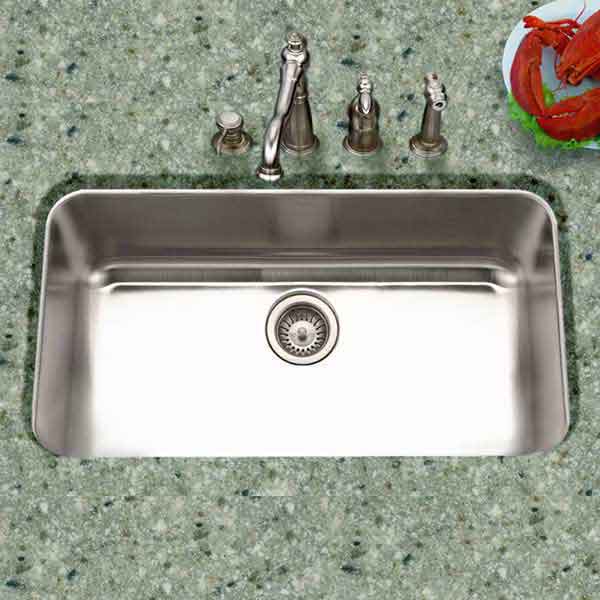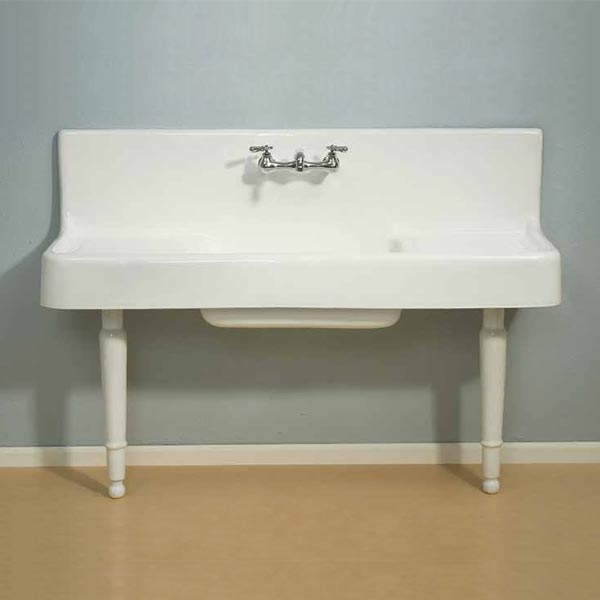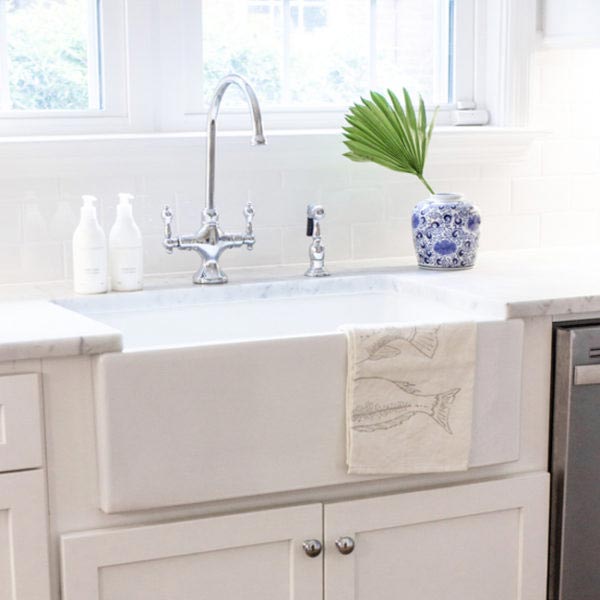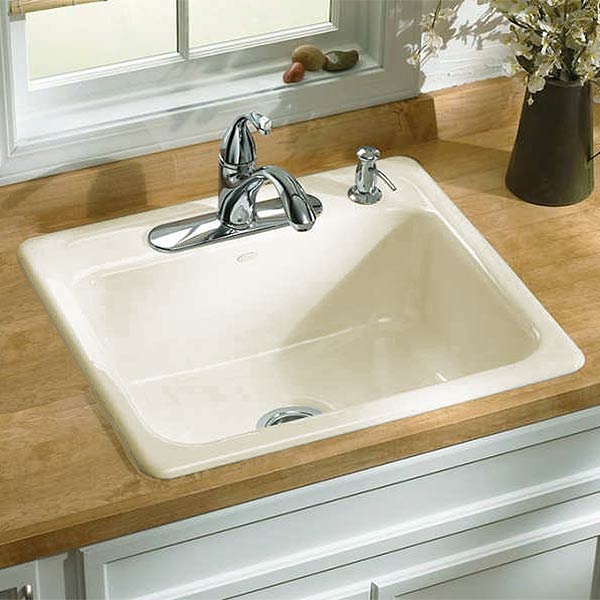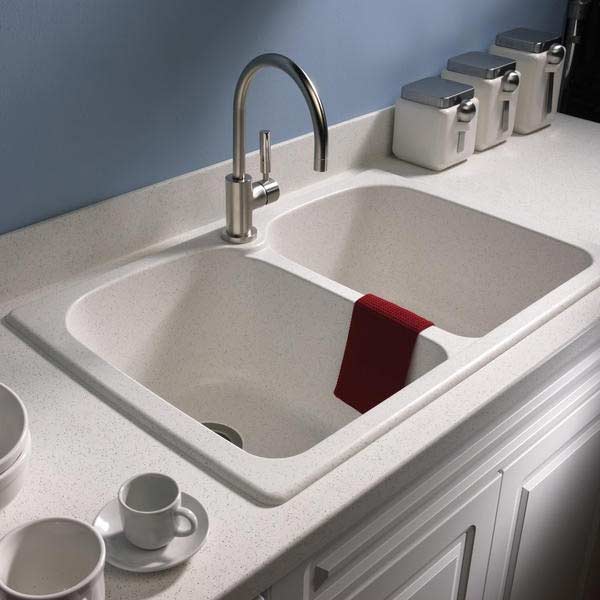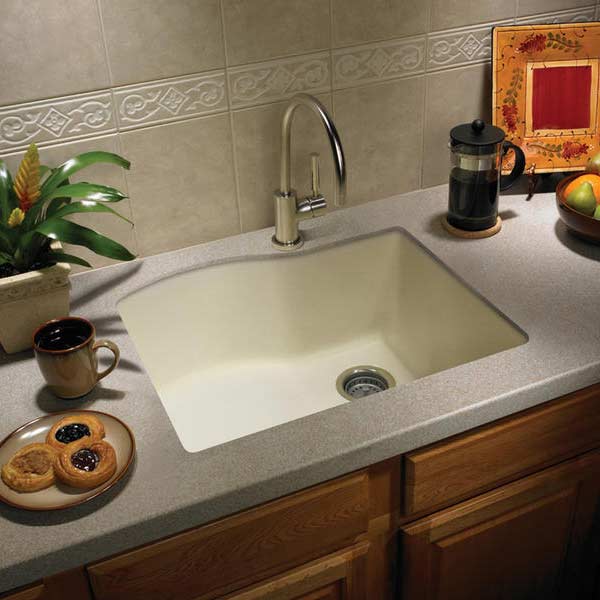Picture yourself in your kitchen cooking, snacking, or preparing a meal. At some point, you’ll likely use your sink. Do you like it? Is it deep or shallow enough? Would you prefer a large single bowl or a double-bowl sink? Does it bring joy or frustration? We want to help you find the perfect sink for you and your family through this guide, whether you’re renovating or just need a new one.
A Simple Guide to Selecting the Ideal Kitchen Sink
When buying a new sink, consider the installation type, size and configuration, and material. Our buyer’s guide covers these options to help you find the ideal kitchen sink and ultimately, your dream kitchen.
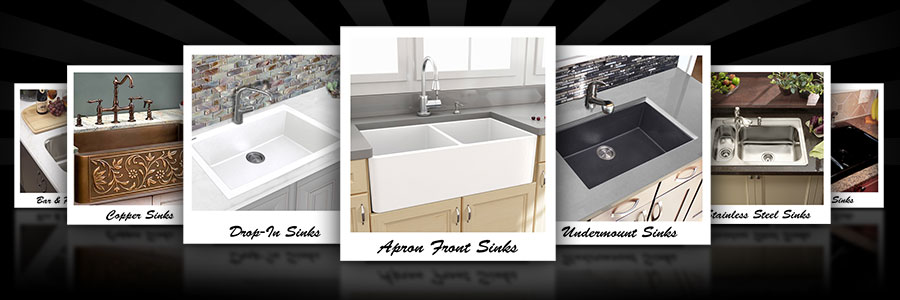
Drop-In
Drop-in sinks, also called self-rimming or top-mount, are easy to install and often save on installation costs. They fit most counter materials and require only a cut-out in the countertop and sealant. These sinks have a rim that rests on the countertop to support the weight, but the height of the rim can range from a few millimeters to an inch, disrupting the countertop’s flow and making it harder to sweep debris into the sink. Dirt and water can accumulate between the rim and counter, but proper installation and cleaning can prevent this.

Undermount
Undermount sinks are installed under the countertop using clips, brackets, or adhesive. Proper installation is crucial as the weight of the sink and contents will hang from the bottom of the countertop. Professional installation is recommended for undermount sinks. These sinks are not suitable for laminate or tile counters that lack the necessary support. Undermount sinks can be more expensive than drop-in sinks, and professional installation can add to the cost. Note that undermount sinks typically lack a faucet ledge and that faucets and accessories must be installed into the countertop or wall, potentially raising installation costs.
When installing undermount sinks, choose the “reveal” amount. This refers to the visible part of the sink’s rim after installation. Positive reveal means the cut-out is larger, revealing the rim below the countertop. Negative reveal means the cut-out is smaller, creating an overhang of countertop around the sink. Zero reveal aligns the sink and countertop edges, creating a straight drop into the sink. The reveal is a matter of personal preference but requires planning and precision for a zero-reveal installation.

Flat Rim
Flat rim sinks are ideal for tiled countertops as they align with the surface. The sink is mounted on a stabilizing layer, usually cement board on top of a plywood base. The sink height can be adjusted to match the finished tile for a flush fit, or to allow 1/4 round tile to drop onto the sink’s edge.
Flat rim sinks are a cost-effective option for tiled countertops, offering an alternative to pricier granite, quartz, or soapstone. With their design versatility and limitless color options, these sinks allow for easy debris wiping directly into the sink. They can also serve as undermount sinks or be used with laminate countertops and a metal sink rim.
Apron Front
Apron-front sinks, also known as farmhouse sinks, have gained popularity recently with the availability of modern stainless steel and stone models. These sinks are now a staple in both modern and traditional kitchens and come in single or double-bowl designs. They are compatible with various counter materials, as long as the cabinetry is modified to accommodate the depth and reinforced to support the weight, especially for heavy fireclay and stone models. Installation by a professional is advisable for apron-front sinks as they need to be properly supported from underneath.
An apron-front sink provides ample sink space and eliminates the need for counter space in front. With a deep bowl, it offers comfortable use, as you won’t have to lean over. However, consider the bowl’s depth as deeper bowls may cause back strain for some. Professional installation is recommended for optimal support.
Sink Size & Configuration
When selecting a kitchen sink, it’s important to focus on your specific usage needs. Consider tasks like dishwashing, accommodating large pots and pans, and the presence of a dishwasher. An honest evaluation of your sink usage will guide you to choosing the best size, design, and material for your sink.



Deciding on the number and size of bowls in your kitchen sink is a key decision. Consider your dishwashing habits and the types of things you’ll be washing. A double-bowl design is convenient for those who wash dishes by hand, allowing for separate spaces for soaking, washing, rinsing, or drying. Those with garbage disposers might prefer a double-bowl sink with one basin smaller. Triple-bowl sinks are also available, with one usually for a disposer, another for food preparation. The size of each bowl can vary with some sinks having equal-sized bowls and others having one large and one small, or two large and one small in the case of triple-bowl sinks.
When choosing a sink, consider how you’ll use it. Double or triple bowls can be great for hand-washing dishes, with one basin for soaking and washing and another for rinsing or drying. But for larger cookware, a big single-bowl sink might be more appropriate. If you still want a double-bowl option, you can use a plastic dishpan to separate the basin when needed. Prep sinks can also be useful, especially in larger kitchens where you need a separate area for food preparation and quick clean-ups.
When selecting a sink, take into account the size of your kitchen and the impact the sink will have on your counter space. In smaller kitchens, a 22″ x 33″ sink may be too large and affect available counter space. Consider a smaller sink, but also think about how it will impact bowl size. A 28″ single bowl may be more suitable than a 28″ double bowl with small bowls. Large sinks mean less counter space, but if you have plenty of counter space or choose a sink with a built-in prep area, this may not be an issue. Consider how you use your sink and your food prep habits when making your decision.
The corner radius is an important factor to consider when choosing a sink. Rounded corners are easier to clean, but they also reduce the bottom area of the sink bowl. If you frequently wash large pots or baking sheets, a sink with zero or small radius corners may be better suited for you, as it provides more space for these items. However, sinks with zero radius corners can be challenging to clean, so if that’s a concern, consider a sink with slightly curved edges and a small radius, which strikes a balance between cleaning ease and sink size.
Another aspect to consider is the placement of the faucet and accessories. If you require specific faucet configurations or accessories, such as a side spray faucet or soap dispenser, you may need a sink with a wider back to accommodate them. Be mindful of these requirements when selecting the size of your sink, especially if you have limited space in your kitchen. Additionally, some locations require a dishwasher air gap, so make sure to check for these codes before finalizing your choice.
Sink Materials
When choosing the material for your sink, consider your usage and habits. Heavy-use sinks benefit from more durable materials like stainless steel or granite composite. If you frequently use heavy pots and pans, porcelain-enameled sinks may not be suitable, as they can easily chip or scratch under heavy weight and force.
Stainless Steel
Stainless steel is a popular and cost-effective material for sinks, known for its durability and longevity. When choosing a stainless steel sink, consider the gauge rating, which ranges from 16-gauge to 22-gauge. The lower the gauge number, the thicker and higher-quality the sink is. While 22-gauge is considered “minimum quality”, a 20-gauge sink can still be satisfactory. However, it’s recommended to opt for an 18-gauge or better sink, as most customers have reported greater satisfaction with these higher-quality sinks, despite the higher cost.
Stainless steel sinks are known for their toughness and long lifespan, and they are also affordable. To maintain their appearance, they need frequent cleaning. Water spots (especially with hard water) and scratches (from abrasive materials or cleaners) are common, and they can lose shine if not dried properly. Despite these upkeep requirements, they are still a popular choice and fit well with any kitchen style.
Porcelain-Enameled Cast Iron & Steel
Cast iron enameled sinks are a classic choice, known for their durability and attractive glossy finish in a variety of colors. However, proper care and cleaning are necessary to avoid scratches, etching, staining, and chipping that can result in rust. Abrasive cleaning methods and strong acids can damage the finish. While heavy cookware and careless handling may also cause damage, a well-maintained cast iron enamel sink is a top-performing and long-lasting option, often at a higher cost.
Enameled steel sinks provide a budget-friendly option for kitchen sink materials. Made with a different base metal than cast iron, steel is lighter and less sturdy, reducing cost. Despite being a budget option, enameled steel can bring both beauty and durability to your kitchen and with proper care, it can serve you for years.
Fireclay
Fireclay sinks, made from clay and minerals fired at high temperatures, offer strength, heat resistance, and a non-porous ceramic surface that resists mildew, mold, and bacteria. Available in various styles and colors, these sinks provide a porcelain-enameled cast-iron look. However, unlike cast-iron, fireclay is solid and does not rust when chipped, but it can crack due to vibrations from garbage disposers, so we don’t recommend using them. If having a disposer is necessary, consider a different sink material.
Fireclay sinks are known for their strength and durability, but their solid build can make them quite heavy, especially for larger sizes. Reinforcing your cabinetry may be necessary before installation.
Acrylic single bowl sink
Acrylic sinks are made from a combination of plastic, fiberglass, and resin, making them a cost-effective and visually appealing choice. They come in a wide range of colors and designs, making them a versatile option for many kitchens. Additionally, their lightweight material makes installation a breeze, making them ideal for retrofits, rental properties, or anywhere you want a durable sink without the added weight. Acrylic’s solid composition allows moderate scratches to be sanded and polished out, and the material is resistant to stains and rust.
Acrylic sinks are known for their resilience and are less likely to break dishes due to their flexibility. However, they are heat-sensitive and may not withstand high temperatures. However, some manufacturers offer SolidCast acrylic sinks that can tolerate up to 450°F, making it a great option for those who want durability and flexibility.
Copper
Copper sinks are an attractive and advantageous choice for your kitchen, but they come with a higher price tag. However, the cost is worth it for the unique appearance and benefits they offer. Copper sinks will not rust and have anti-microbial properties, as verified by EPA-registered manufacturers. Studies show that bacteria cannot survive on a copper surface for more than a few hours.
Copper sinks, while pricier, are a beautiful and beneficial choice for your kitchen. Not only do they have a unique appearance, but they are rust-resistant and have anti-microbial properties. According to studies, bacteria cannot survive more than a few hours on copper. However, copper is a reactive material and its look will change over time as it develops its natural patina, which can range from a darkening of the initial bright finish to hues of blue and green. To preserve its original appearance, a sink can be polished but this will also seal the finish, reducing its anti-microbial properties.
Solid Surface
Solid surface, made of resin and minerals, is a non-porous alternative to natural stone used for countertops, sinks, and tubs. It is versatile, durable, and can be repaired. Scratches on a solid surface sink can be sanded and polished out. Its uniform composition means it can resist chipping and be easily cleaned, but avoid using metal scouring pads as they can cause severe scratching. Swanstone, the manufacturer of our solid surface sinks, states that normal scratches can be easily buffed out.
Solid surface is a non-porous and flexible material made of resin and minerals, ideal for countertops, sinks, and tubs. It is durable, easy to clean and repairs are possible for minor scratches. It is also more forgiving to dropped dishes than other materials like cast-iron or natural stone. It can withstand temperatures up to 450°F, making it a low-maintenance option for your kitchen sink. However, repairing any significant damage requires professional attention, which can be expensive.
Stone (Granite/Composite/Marble)
Stone sinks bring a unique beauty to your kitchen. We offer three options: 100% Marble, 100% Granite, and Granite Composite (consisting of 85% quartz granite and 15% acrylic resin). These sinks are heavy and require proper cabinet reinforcement for installation. Granite and marble sinks are often seen in apron-front style to showcase their appearance. They come in various designs – chiseled, carved or polished, depending on your preference. Natural stone is porous, so initial sealing and regular maintenance is needed to prevent staining.
For a more affordable option, granite composite sinks offer the same durability and heat resistance as natural stone sinks. Made of 85% quartz granite and 15% acrylic resin, they have a high resistance to heat (rated to 530°F) and are dense, reducing noise compared to other sink materials like stainless steel. Although they shouldn’t require resealing, lighter colored composite sinks may be prone to staining and dark ones may show hard-water spots if not dried regularly.
